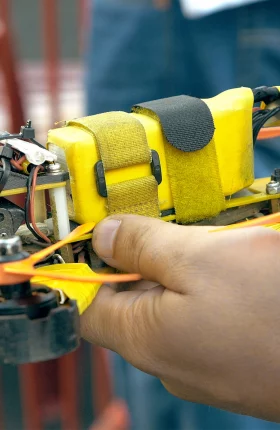The range of potential applications for airborne drones is expanding rapidly, from agriculture to construction to futuristic options such as package delivery. Growing just as fast is the need to control these machines while they’re airborne. The US market for unmanned aerial systems (UASs)—which coordinate the flight of hundreds or even thousands of drones from a single site—is projected to grow by 13% a year through 2027. And the market for a related type of technology, called unmanned traffic management (UTM), is growing just as fast. UTM systems are sold to governments and municipalities to control multiple UAS fleets, as well as the interface between drones and piloted aircraft operating close to one another.
Like commercial aviation in its earliest days, the UAS and UTM market is wide open for ambitious players to stake a claim and seize market share. Companies and government entities are working to establish standards, set regulations, and forge relationships, meaning that the next several years will be pivotal in gaining a competitive edge.
To capitalize on this period of growth, we believe that companies should focus on three priorities: developing differentiated offerings, identifying sustainable sources of revenue, and obtaining the required certifications to establish credibility among potential customers.
Three Factors Are Driving Growth
The UAS market is an ecosystem comprising several players, and it’s critical for companies to actively build relationships with all of them in order to gain access and win business. (See “Key Participants in the UAS/UTM Market.”)
Key Participants in the UAS/UTM Market
- The Federal Government. Both the FAA and NASA are responsible for leading the overall development of key applications and use cases, establishing the fundamental architecture for data exchange, and setting standards for the safety and security of drone operations.
- Test Site Operators and Lead Researchers. The FAA has designated seven test sites across the US, operated by universities, municipalities, and other organizations, where companies can test drones and UAS fleets under controlled conditions. In addition, the FAA has established the Integration Pilot Program, which brings private-sector players together with local governments to evaluate how drones can be more widely integrated into US airspace.
- Commercial Companies. UTM platform providers, UAS developers, service providers, and drone operators are the driving force in advancing the technology and developing real-world applications and use cases. Because regulations and standards are still being developed, it’s critical for commercial players to actively collaborate with the FAA and NASA and establish a presence at key industry forums. They should also participate in trade groups such as the Global UTM Association and advisory groups such as the FAA’s Drone Advisory Council.
Overall, the market is growing fast, as new applications continue to create value for customers. Total UAS sales in the US are projected to nearly quadruple, from $600 million in 2019 to $2.3 billion in 2027. (See the exhibit.) Our discussions with 15 leaders of federal and state authorities, drone test sites, and UAS and UTM companies indicate that continued growth in the market will result from three main factors.
The range of applications is growing. Several fleet-level UAS applications are already in wide use, such as in precision agriculture and the monitoring of industrial sites. For example, many utilities find that inspecting difficult-to-access sites using a video-enabled drone is far easier than getting a technician in place to inspect the site directly. Companies are also experimenting with the use of drones to deliver packages, although that would obviously require additional technology and safety standards to protect people on the ground.
Regulations for the base technology are easing. Currently, US regulations for drones are established by the Federal Aviation Authority and derive from the rules governing traditional piloted aircraft. Because the consequences of a plane crash are so significant, these standards are understandably stringent. Our conversations with leaders in the drone industry suggest that the system-driven nature of UAS fleets—with a single controller overseeing multiple drones, often with PC-based software running on mobile platforms—has been a key factor in shaping the standards’ evolution. Through dialogue with the industry, the FAA is making gradual progress toward adjusting the regulations and setting the right level of oversight for unmanned drones. As the regulatory environment eases, more players will develop the base technology that powers UAS fleets, creating more momentum in the market.
Like commercial aviation in its earliest days, the UAS and UTM market is wide open for ambitious players to stake a claim and seize market share.
Commercial manufacturers are pushing for standardized technology. The FAA typically works closely with major OEMs to set technical standards. Most of the largest OEMs focus on their traditional aviation business (as well as on military drones, currently a far bigger market than commercial drones). Commercial drone manufacturers are generally much smaller than the OEMs, and they lack the scale and scope needed to work directly with government to shape regulations. As commercial manufacturers gain a larger role over the next ten years, however, we believe that key technologies and standards for the UAS market will continue to evolve, with a long-term shift toward a more accessible market.
Moreover, the relationship between UTM and UAS players is still in flux. Many UTM services in the US still generate revenue through straight sales, rather than through subscription services. As a result, key UTM players are expanding into adjacent UAS applications and value-added services to boost sales. AirMap, for example, a leading UTM player in the US, recently acquired Hangar Technology, which provides route optimization capabilities for UAS solutions.
Imperatives for the US Market
We believe that any company looking to enter—or expand in—the UAS and UTM market in the US should focus on three key measures.
Develop differentiated offerings. The US market is crowded, with hundreds of companies developing new applications and offerings. As a result, companies need to identify emerging market trends, attractive customer pools, and the ways in which their own offering can stand out. For example, manufacturers can build UAS offerings with analytics fed by highly localized weather data to track ground-level environmental changes, or they can build them with real-time fleet management tracking and remote ID that provides identification information to third parties to ensure flight safety.
Identify sustainable sources of revenue until the market matures. To establish an effective market position, players must consider business sustainability in the near term and brand awareness in the long term. In the near term, it’s critical to establish a stable revenue source that can meet cash flow needs and bridge the gap until the US market takes off. Because organic development can be time- and resource-intensive, partnerships or even acquisitions of competitors with unique capabilities could be a viable option to ensure sustainable revenue. In the long term, companies should shape the future of the UTM business model by leveraging their strong position in vertical applications to ensure that commercial use cases, such as infrastructure monitoring or package delivery, remain viable.
The next several years will be pivotal in gaining a competitive edge.
Obtain the required certifications to build credibility. The right certifications are crucial as well. For example, remote ID is an emerging FAA requirement that will allow governmental and other authorities to identify all the drones in their airspace (similar to how transponders function on piloted aircraft). Another example is a system called Low-Altitude Authorization and Notification Capability, which automates the process by which drone operators request airspace approval.
Manufacturers should also obtain the certifications required to access any secure information that may be relevant to their commercial use case or when seeking government contracts. Certain government contracts—even outside of military applications—may require access to classified material and are limited to companies that have the necessary security clearance. Gaining this approval requires that companies meet certain conditions, such as having board members with US citizenship.
To gain further credibility, players should use FAA-approved test sites or participate in the Integration Pilot Program. They should also engage in dialogue with the FAA on the rules and standards for acquiring early UTM qualification. Similarly, many key players in the market are using FAA-approved test sites not only because of their capabilities but also as a means to establish relationships with the FAA and other key people in the US market. As an executive at the FAA-approved test site in North Dakota told us, “Working through the FAA test sites will make you a more relevant player.”
The UAS/UTM market in the US is at an exciting inflection point, not only because of its high growth prospects but also because companies can actively work with regulators over the next several years to set standards and shape the industry’s future. Leadership teams that take the right steps to capitalize on this critical window will position themselves to control the skies.







